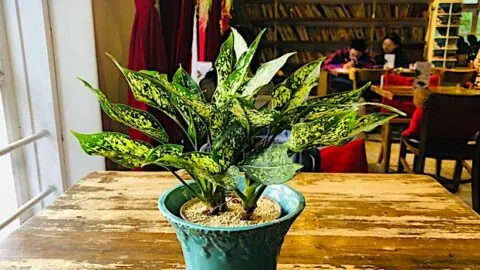Table of Contents
Chinese Evergreen (also known as Aglaonema modestum, A. commutatum) is a group of plants that are valued as symbols of good fortune across Asia as well as being favourites of interior designers.
They belong to the Araceae family according to the University of Oklahoma.
They have become some of the most popular houseplants due to their easy-going nature and beautiful variegated leaves.
The University of Florida simply calls them tough and good looking.
You will see them in homes, offices and commercial spaces all over the world thanks to their ability to tolerate low light conditions away from direct sunlight.
In this article, I am going to show you how I care for my Chinese Evergreen and what works best for my plants.
Chinese Evergreen Care
To care for Chinese Evergreen ensure the temperature is between 64-77° F (18-25°C) and provide bright indirect light. A mix of 50% sand or perlite and 50% potting mix works best. Water about once a week in spring and summer and provide >60% humidity for the best growth.
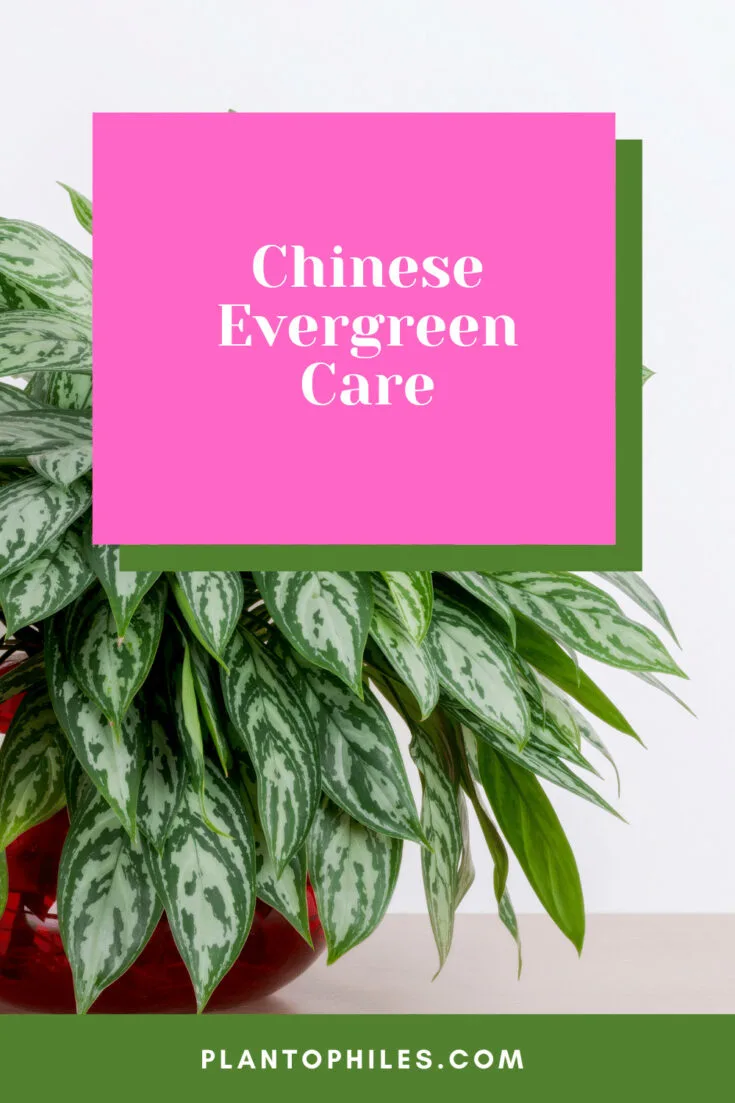
Chinese Evergreen Care
CHINESE EVERGREEN CARE
Soil
Chinese Evergreen are adaptable, easy-going plants that are happy with a 50% mix of general potting soil and 50% of sand or perlite.
This will keep the soil at the ideal porosity for the level of drainage that the plant enjoys.
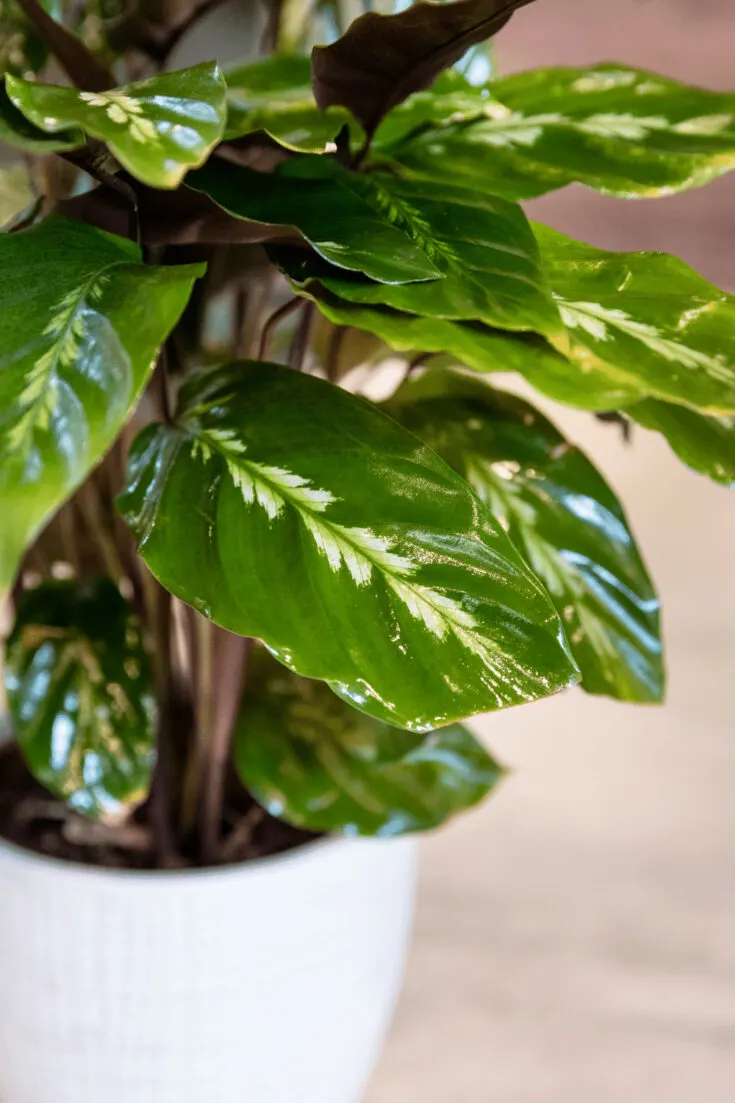
A potting soil of 50% potting mix and 50% sand and perlite
Light
Provide a Chinese Evergreen with bright indirect light for the best growth.
All varieties of Chinese Evergreen are adapted to living in lower light conditions so place your plant in a position without any direct sunlight.
Varieties that are variegated with a pinkish-red colouration such as Red Emerald are more tolerant of brighter conditions whereas dark-leafed varieties such as Aglaonema Maria are better suited to lower light conditioned areas of your home.
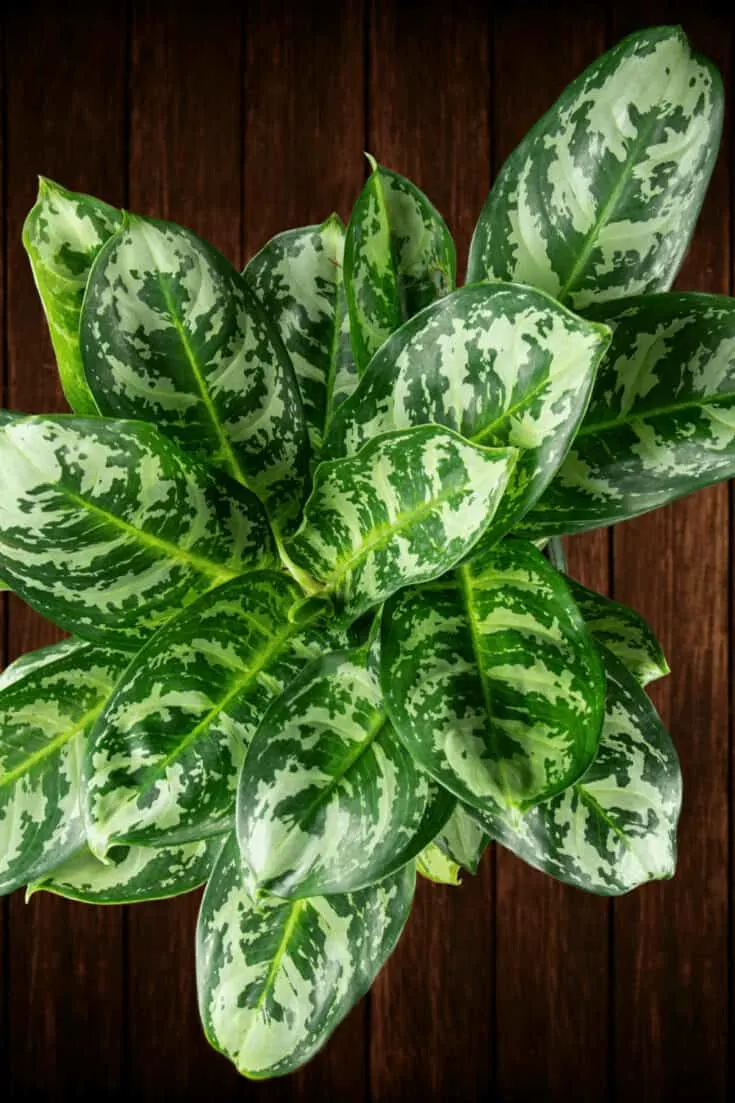
Chinese Evergreen need bright indirect light and are tolerant of lower light conditions
Watering
You only need to water your Chinese Evergreen once a week in the growing season, and only every two or three weeks during winter.
If you are unsure whether your plant needs water, test the soil for moisture with your finger to a depth of one inch. If it’s still moist wait another day or so for watering, if it’s dry, then this is the perfect time to water.
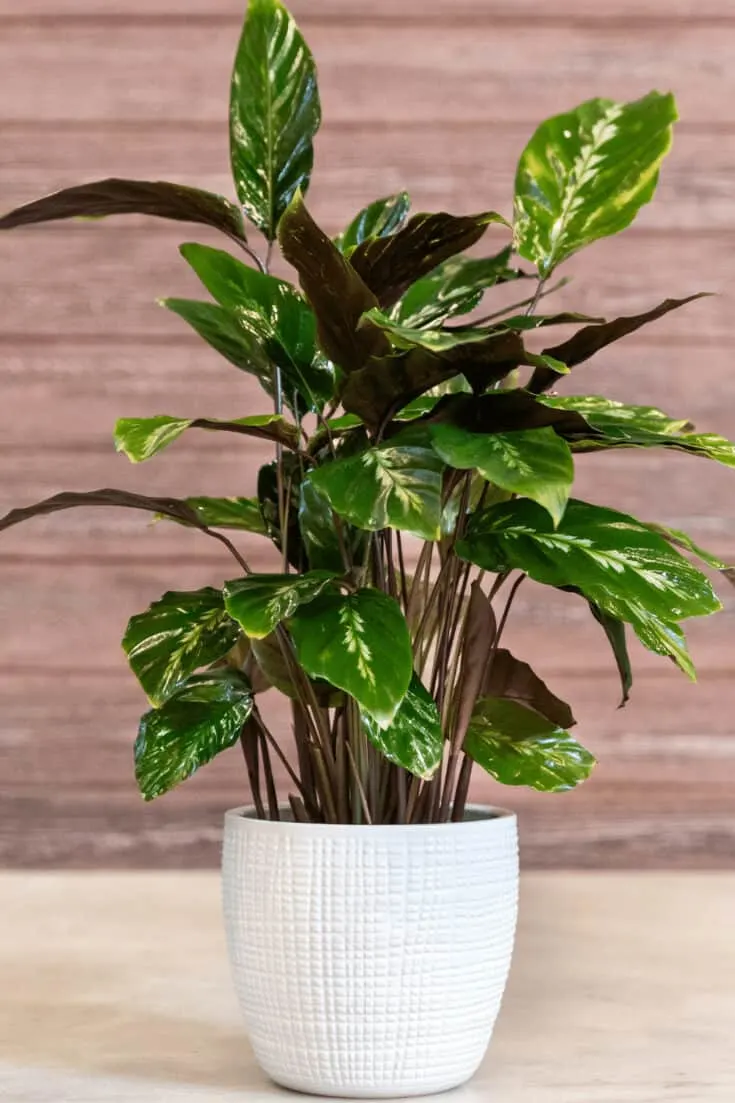
Water Chinese Evergreen about one a week in spring and summer
Temperature
Chinese Evergreen are the ideal house plant as their optimal temperature range is 64-77° F (18-25°C).
These plants are very comfortable at room temperature, although they will tolerate as low as 60°F (16°C).
Any colder than this for prolonged periods and the plant will start to show signs of stress such as brown spots on the leaves.
Humidity
Chinese Evergreen prefer a humidity of >60%.
But Chinese Evergreen are hardy plants that can tolerate a range of conditions, but they prefer some humidity.
They are well suited for bathrooms or kitchens where humidity can be higher, but they are equally capable of tolerating less humid rooms such as your office or living room as long as they are kept at the right temperature.
If you are in a particularly dry climate then spraying your Chinese evergreen with a mister every couple of days will keep it humid and happy.
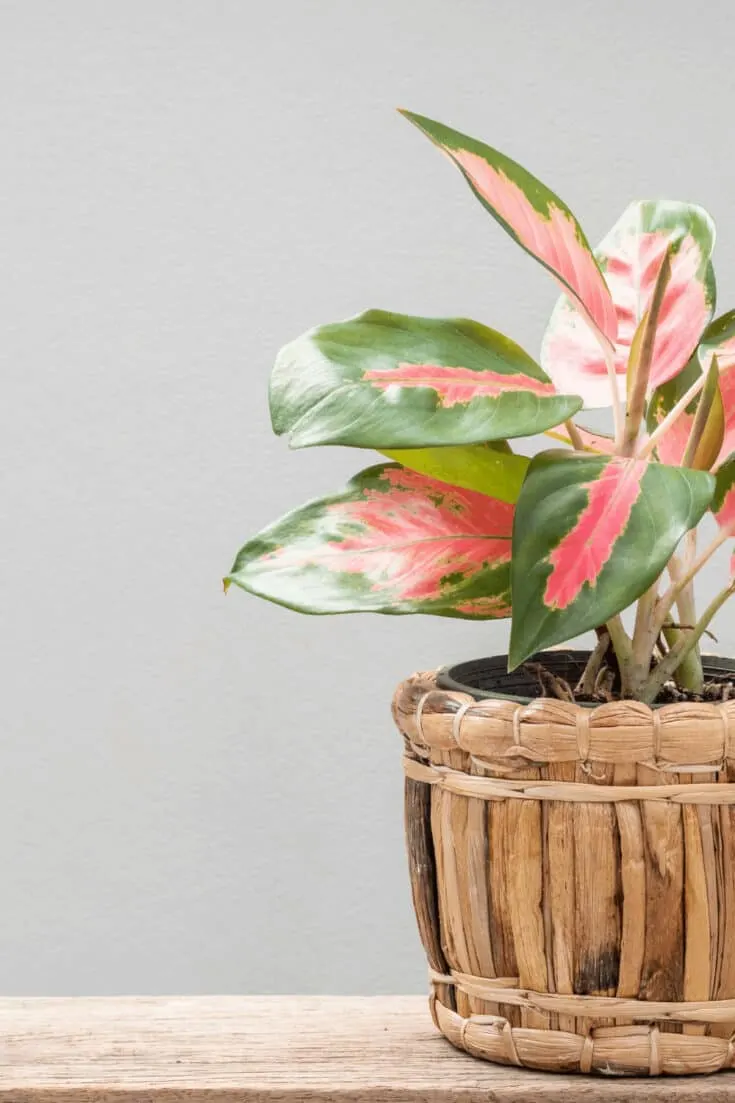
Chinese Evergreen tolerate lower humidity but will thrive at 60%+
Fertilizer
Fertilize Chinese Evergreen with a liquid fertilizer diluted to half-strength once a month in the growing season.
Our leafy, low maintenance friend does not require much fertiliser but can be susceptible to damage if over fertilised, (too much will burn the roots).
Use half-strength diluted regular house plant fertiliser once a month during the growing season and your plant will thank you for it.
In Autumn and Winter do not fertilize or every 2-3 months max.
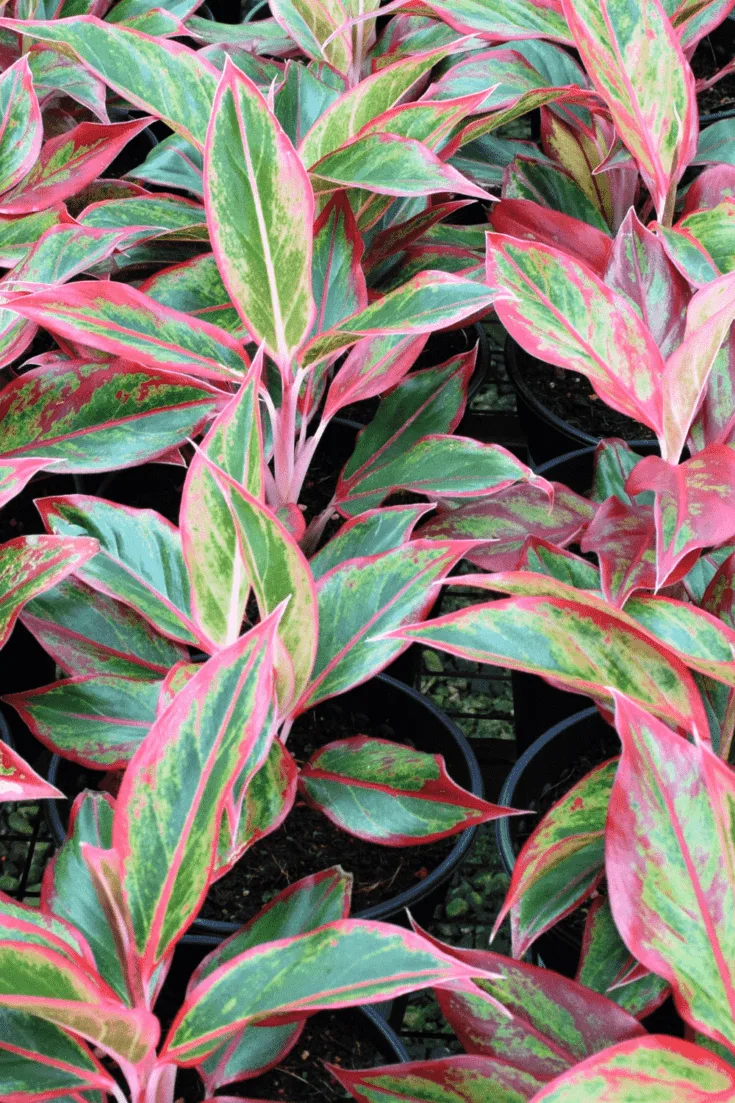
Fertilize once a month in spring and summer
Propagation
Chinese Evergreen is best-propagated through division.
Chinese Evergreen are the ideal plant if you’re inexperienced with propagation.
During the growing months, simply divide an established plant by gently teasing apart a clump of roots and separating them from the main plant.
Place your new plant in a pot of soil and give a generous watering in the first week to avoid dehydration.
You can also propagate from stem cuttings by choosing a stem with a minimum of 5 leaves and planting in directly in soil.
Keep the cuttings well watered for the first 3 weeks and then resume a normal watering schedule of watering once a week. New shoots should be visible after 3 weeks from the main stem.
Growth
Chinese Evergreen can grow up to 3 feet wide and 3 feet high (92cm) depending on the cultivar.
Chinese Evergreen are a favourite of interior designers as they have beautiful variegated foliage, and they’re not big growers so the plant will stay proportionate in size to its chosen location for a long time.
The size of your Chinese evergreen will be limited by the size of your pot, but given the ideal conditions, some varieties like Aglaonema Silver Bay can grow to 3 feet tall and 3 feet wide.
You can prune and divide plants easily to keep them to your desired size if this is too large.
Potting
All varieties of Chinese Evergreen are relatively slow growers and will require repotting to a bigger pot about once every 2 years.
Repot in the spring and provide your evergreen with replenished soil to keep it healthy. This is also a great opportunity to reduce the size of your evergreen by dividing the clumps of roots for propagation.
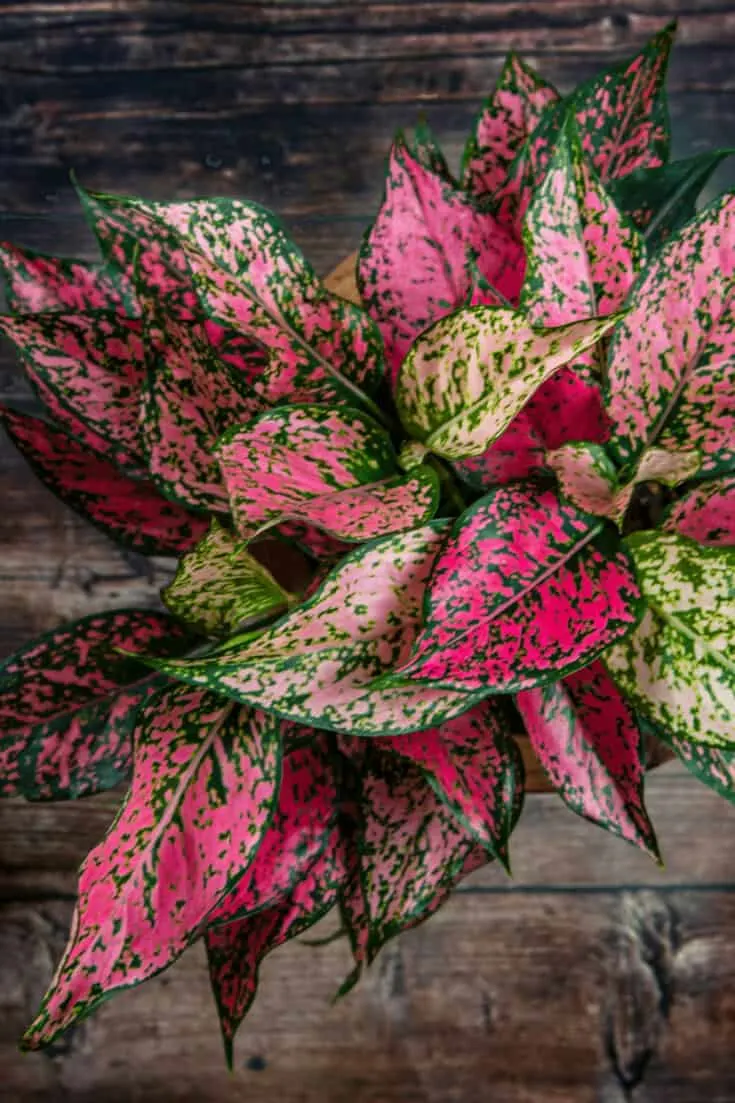
Chinese Evergreen has striking foliage and comes as multiple cultivars
WHAT DOES CHINESE EVERGREEN LOOK LIKE?
All cultivars of Chinese Evergreen have an abundance of attractive variegated foliage which can range from the bold, deep red of the variety ‘Red Emerald’ to the silvery and dark green leaves of the popular variety ‘Silver Queen’.
Established plants produce several pale green/white flowers of understated beauty every year.
The leaves are large and narrow and taper to a point with a glossy sheen.
The plant produces inedible red berries that contain a seed and ripen towards the end of the growing season.
Did you know?
Chinese Evergreen are good for your health. The large surface area of their leaves purifies the air effectively by filtering harmful air pollutants and toxins whilst producing oxygen to improve the air quality of your home or office. – Plantophiles
THE ORIGIN OF THE CHINESE EVERGREEN PLANT
Chinese Evergreen are not only native to China but to all sub-tropical and tropical regions of Asia and the island New Guinea in Oceania.
All species have adapted to thrive in the shady, humid conditions underneath dense tree cover in their tropical forest habitat.
They were first cultivated in the western world in 1885 at the Kew, Royal Botanical Gardens where different varieties were grown and hybridised into the wide array of colourful variegated cultivars that we see today as popular houseplants.
PROPAGATION OF CHINESE EVERGREEN
Propagation is a great way to produce another beautiful variegated plant for you to enjoy and thanks to the hardy nature of the Chinese Evergreen the success rate of new growth is higher than most other house plants.
The two easiest and most successful methods of propagation for your Chinese Evergreen are:
- Propagation by dividing the roots of the plant
- Propagation from stem cuttings
PROPAGATION BY DIVIDING THE PLANT
By far the easiest and most successful method in my experience of propagating Chinese Evergreen is by dividing the plant in the spring during repotting.
This way you achieve two objectives at once:
- Decrease the size of a plant that has outgrown its home
- Produce a new plant to enjoy around the house
Remove the plant from its pot and inspect the root ball.
Gently work the dirt apart from the roots with your hands and try to keep as many intact as possible.
Do not be afraid of making a strategic cut with a sharp, sterile knife or pair of scissors to a root to help untangle a collection of roots and stems.
If an established plant has been in the same pot for too long (more than two years) then roots may be amassed in a tight root ball.
It’s realistically impossible to separate with just your hands.
In this situation, you can afford to make a more decisive cut through the root mass with a knife to divide the plant into smaller, more manageable sections.
It is always better to leave as many roots intact but Chinese Evergreens are hardy plants and can cope with some tough love.
Once you have separated the sections of roots and stems, place each new section into a new pot with fresh potting soil mixed with 50% sand or perlite.
With your hands, firm the soil around the base of the new plant to give it some support and give your new plant a good soak.
For the first week, water the plant every couple of days.
Then resume a normal watering cycle of one good soak every week in the growing months.
Water once every two or three weeks during the winter months and you will have a healthy new plant.
PROPAGATION FROM STEM CUTTINGS
If you have an established Chinese Evergreen with multiple stems, then it will be a good candidate from propagating with stem cuttings.
With more mature specimens there are often stems that have a higher proportion of leaves towards the top of the stem.
You will also have a longer, more exposed section lower down the stem where the lower leaves will have withered away.
These are the stems that are much better suited for propagation.
Cut your chosen stem with a sharp, sterile knife about an inch above the soil.
Place the stem as deep into a fresh pot of potting soil (with a 50% mix of sand or perlite for drainage) as deep as you can.
Be sure to give the soil a good soak before planting your cutting.
Placing the stem as deep down into the soil as possible (without burying any petioles).
This will provide the plant with support and give it a greater opportunity to develop roots.
It is crucial to water the new stem cutting regularly in the first two weeks.
While the roots are developing and then you can resume a normal watering schedule of one good soak a week in the summer.
Water once every two or three weeks in the winter.
Always position your propagating Chinese Evergreen away from direct sunlight and out of overly draughty areas.
It is possible to propagate your stem in a jar of water first, but in my experience, the roots that develop in water are often delicate and are liable to damage when you transfer the cutting its pot.
So for a higher success rate, I always recommend planting your cutting straight into the soil.
DO DIFFERENT VARIETIES OF CHINESE EVERGREEN NEED DIFFERENT CARE?
All Chinese Evergreen thrive in the same conditions of indirect sunlight and a weekly watering schedule.
The difference being that varieties with red or pinkish variegated leaves (such as Aglaonema Crete) that tend to tolerate brighter conditions than their darker green-leafed relatives (Aglaonema Maria, for example).
They can even grow in a windowless office with just artificial light.
Other than that you can treat your different cultivars of Chinese Evergreen just the same!
5 TIPS TO KEEP YOUR CHINESE EVERGREEN IN GREAT SHAPE
- If you live in a particularly dry climate, then your Chinese Evergreen will benefit from the occasional mist spray on the leaves. If the leaves of your plant have brown tips, then this is a sign of stress due to lack of humidity so give your plant a quick spray once a week and monitor it to keep it happy.
- Chinese Evergreen are hardy plants that are content in regular potting soil, but they do appreciate good drainage, so make sure you include a 50% mix of sand or perlite, so you don’t drown your tropical friend.
- All verities of Chinese Evergreen will be happy if you give them a good soak once a week during the summer and once every two or three weeks in the winter. If the leaves of your plant turn brown that this can be a sign that it is either overwatered or too dry. If you are unsure when to water, check for moisture to a depth of one inch in the surrounding soil with your finger. If it’s completely dry, then give the plant a drink as normal. If the soil is still slightly moist, then wait a couple of days before watering and try again.
- Chinese Evergreen love the shade and can even tolerate artificial fluorescent light as their only light source, so keep them in a nice shady spot in your home or office for a happy life.
- Your plant may produce multiple light green/white flowers in the growing season. Deadhead these flowers as soon as they begin to turn brown so that the plant redirects its energy into producing more flowers or back into the plant rather than into developing seeds.
5 THINGS YOU SHOULD NEVER DO WITH YOUR CHINESE EVERGREEN
- Avoid positioning your plant directly in the airflow of an air conditioner or too near a source of heat. These conditions can dry out your sub-tropical plant so keep them away from draughty areas to keep your leafy friend happy.
- Make sure your plant’s container has a drainage hole in the bottom so that any excess water can flow out the bottom of the pot unhindered. Your Chinese evergreen will not be happy with consistently wet feet as this will lead to root rot.
- Your Chinese Evergreen has evolved to love life on the forest floor in shaded areas, so keep your plant out of any direct sunlight. If your plant receives too much sun, the leaves will turn brown and greasy as a sign of stress, so keep them in a nice shady spot in your home or office.
- Do not over water your plant in the winter. Remember they love to be in the shade so in the cooler months these plants will not dry as often as plants that receive direct sunlight. Watering once every three weeks is optimal for the health of your plant in the colder months. Remember you can test with your finger for moisture in the soil if you are unsure. If the soil is still moist, hold off watering for a few days.
- Avoid over fertilising your Chinese Evergreen. These plants only need a half-strength, standard house plant fertiliser once a month in the growing season. And no fertilising at all in the winter months. The roots are sensitive and can burn due to an accumulation of salts if you feed them too often. Treat them mean and keep them keen!
CHINESE EVERGREEN POISONOUS
The Chinese Evergreen is poisonous to cats and dogs as well as humans according to the University of Kansas.
Symptoms are vomiting, diarrhea and rash.
The leaves as well as the stems contain toxins.
FREQUENTLY ASKED QUESTIONS ABOUT CHINESE EVERGREEN
Is Chinese Evergreen poisonous?
All parts of your Chinese Evergreen plant are poisonous to humans, cats, dogs and other pets if it is ingested. This includes the red berries that are produced in the summer. The sap from leaves can also cause skin irritations. If ingested seek medical help immediately.
Is Chinese Evergreen exclusively found in China?
Chinese Evergreen are widespread, hardy plants that are found all across tropical and subtropical Asia, and stay hidden beneath the forest canopy in Thailand, Vietnam, Cambodia, Philippines, Malaysia and even in the Southern Hemisphere in New Guinea. They are kept as house plants in many of their native countries and are a symbol of good luck.
What is the most popular variety of Chinese Evergreen?
The most popular cultivar for indoor house plants is the ‘Silver Bay’ variety that is native to the Philippines. The dark green leaves are contrasted with silvery variegation that runs down the centre of the leaf. They are known for their hardy nature and are particularly good at thriving in lower light making them a favourite decorative and practical plant for interior design.
CONCLUSION ABOUT CHINESE EVERGREEN

Daniel has been a plant enthusiast for over 20 years. He owns hundreds of houseplants and prepares for the chili growing seasons yearly with great anticipation. His favorite plants are plant species in the Araceae family, such as Monstera, Philodendron, and Anthurium. He also loves gardening and is growing hot peppers, tomatoes, and many more vegetables.

